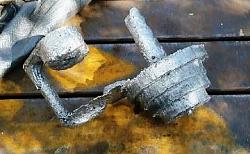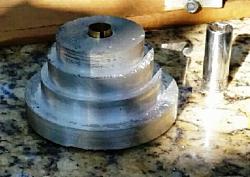There was some but it was widely separated small dots and to me didn't affect the integrity enough to be concerned about.
I first intended to use Light Salt to degas the AL but several videos I've watched since have convinced me that it doesn't work so I just poured the metal trying to keep impurities to a minimum. Apparently you need a costly bubbler rig to achieve significant degassing. I did use a smallish tapered sprue along with the Campbell pouring basin design which eliminates gulps of air while filling and there weren't any voids that I saw during machining. The foam outgassing as it vaporized left a terrible surface though.
That just reminded me that I forgot to take a picture of and mention that I made a fixture to turn wooden tapered sprue forms on my table saw.
Another metal casting tip that I forgot to mention: Plan all your moves in advance so that you can setup for the pour and make it with no improvising or adapting during.


 LinkBack URL
LinkBack URL About LinkBacks
About LinkBacks


 Reply With Quote
Reply With Quote




Bookmarks